
Blend of Digital and Non-Digital Solutions
NON DIGITAL SOLUTIONS
Co-creation activities
Stated-preference survey
DIGITAL SOLUTIONS
Fotefar mobile application
Mobility observation box
The Mobility Observation Box (MOB) makes it possible to measure the safety of transport infrastructures according to objective criteria and thus make them comparable. Once data collection is done, machine learning algorithms automatically recognize different groups of road users (pedestrians, cyclists, cars, trucks, e-scooters, etc.), detects them, evaluates their traffic behavior using surrogate safety measures and provides a basis for targeted mitigation measures. The battery-operated system allows a quick and uncomplicated installation and deinstallation of the box, not requiring a supplemental power source. Due to its small size, data collection of all traffic participants can be realized without distraction or influence.
Big data platform
The Big data platform will be used for AMIGOS data storage and processing. Most of the data will be mainly provided by the cities (car traffic, bikes traffic, pedestrians, noise and air pollution data, Mobility Observation Box data from each city…) in different points in time. This data will feed the solutions to be developed (for example, air and noise pollution improvements or optimizing the existing transport network). This data will be crucial to the development and utilization of the three digital urban twins. It will present interesting data for city authorities, local transport authorities and researchers.The data is a combination of accumulated data: Big Data and the real-time (RT) streaming data. The real time data is the data representing current values provided by relevant providers e.g. IoT. This data, after being analysed, defines events to be handled by the city as soon as possible e.g. air quality related events.
The Big Data platform will provide predictions and pattern recognition to be used together with the Real-Time Data to define events that will help to come up with recommendations to address the specific per city challenges.
Digital twins
ITAINNOVA is going to develop Digital Twin, virtual copy of a real-world item or procedure. It is a dynamic model , created with historical data and updated in real-time to represent the physical object or process. Digital twins track, examine, and forecast how physical things or processes will behave. They can boost performance, reduce downtime, and increase efficiency.
Digital twins have the potential to revolutionize the mobility and transport industries. They can be used to improve efficiency, reduce congestion, and make transportation more sustainable. Traffic management: Digital twins can predict traffic conditions with behavioral hypothesis. This information can be used to optimize traffic lights, reroute traffic around accidents, and provide drivers with updates on traffic conditions. The trafic scenarios can be updated with information about the status of the infrastructure, such as roads, bridges, and tunnels. This information can be used to identify potential problems before they cause significant disruptions and to plan for maintenance and repairs.
Public transportation: Digital twins can be used to improve the efficiency of dynamic public transportation systems. They can be used to optimize routes, schedules, and fares.
